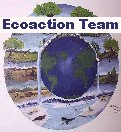Announcements and News:
Site Navigation:






Page address:
File created:
Feb 12, 2002
Last modified:
Apr 9, 2002
Definitions:
Double-click on any word
Announcements and News: |
 The Connecticut River is the only principal river in the northeastern United States without a major port, harbor or urban area at its mouth. This is the result of shifting sandbars in Long Island Sound which impede navigation, and this situation has served to preserve the largely rural character of the regional landscape and maintain the river's extraordinary assemblage of natural and relatively undisturbed biotic communities. The lower Connecticut River, beginning near its mouth and continuing upstream for a distance of approximately 58 kilometers (36 miles), contains one of the least developed or disturbed large-river tidal marsh systems in the entire United States, and the most pristine large-river tidal marsh system in the Northeast. From a regional standpoint, there are no other areas in the Northeast that support such extensive or high quality fresh and brackish tidal wetland systems as do those in the Connecticut River estuary. (from http:// dep.state.ct.us/ olisp/ramsar/ intro.htm)
The Connecticut River is the only principal river in the northeastern United States without a major port, harbor or urban area at its mouth. This is the result of shifting sandbars in Long Island Sound which impede navigation, and this situation has served to preserve the largely rural character of the regional landscape and maintain the river's extraordinary assemblage of natural and relatively undisturbed biotic communities. The lower Connecticut River, beginning near its mouth and continuing upstream for a distance of approximately 58 kilometers (36 miles), contains one of the least developed or disturbed large-river tidal marsh systems in the entire United States, and the most pristine large-river tidal marsh system in the Northeast. From a regional standpoint, there are no other areas in the Northeast that support such extensive or high quality fresh and brackish tidal wetland systems as do those in the Connecticut River estuary. (from http:// dep.state.ct.us/ olisp/ramsar/ intro.htm)
You will use this estuary to study ways that natural systems can be preserved and managed. The outline and links below indicate topics for paragraphs that will write, based on your reading. Include the URL where you found supporting information for each paragraph. The topic statements/questions have useful links with them.
1. Background: What is history of human use of the Connecticut River estuary? See http:// dep.state.ct.us/ olisp/ ramsar/ socio.htm
 2. Natural Processes: How does the estuary function? What
natural processes are at work in the estuary? See http:// dep.state.ct.us/ olisp/ ramsar/ sitedes2.htm and http:// dep.state.ct.us/ olisp/ ramsar/ interimp.htm.
2. Natural Processes: How does the estuary function? What
natural processes are at work in the estuary? See http:// dep.state.ct.us/ olisp/ ramsar/ sitedes2.htm and http:// dep.state.ct.us/ olisp/ ramsar/ interimp.htm.
3. Cultural Actions: How does the estuary affect
people, how do we change the natural processes
and make things worse or better from a societal point of view? See http://dep.state.ct.us/olisp/ramsar/socio.htm
 5. Planning: Describe the activities and roles of the private, town, state and federal groups that are working together to preserve and manage the
Connecticut River Estuary. See http:// dep.state.ct.us/ olisp/ ramsar/ mgmtprac.htm and http:// dep.state.ct.us/ olisp/ ramsar/ research.htm
5. Planning: Describe the activities and roles of the private, town, state and federal groups that are working together to preserve and manage the
Connecticut River Estuary. See http:// dep.state.ct.us/ olisp/ ramsar/ mgmtprac.htm and http:// dep.state.ct.us/ olisp/ ramsar/ research.htm
6. Individual action: What can we do as individuals in our daily lives that can affect the estuary? See http:// www.epa.gov/ region01/ questions/ archive/ 20001026_nonpoint.html
7. Conclusion: "In summary, the Connecticut River estuary and tidal wetlands represent the most productive and diverse estuarine system for fisheries in New England. As a reflection of that productivity, the project area also supports the greatest fishing effort, recreationally and commercially, of any river system in New England. The river's location in the densely populated region of New England, halfway between New York City, New York, and Boston, Massachusetts, provides easy access for millions of anglers. This location, coupled with the river's high environmental quality, presents tremendous fishing and economic opportunities for the regional populace."
From: http:// dep.state.ct.us/ olisp/ ramsar/ interimp.htm
(Return to top of page)




Page address: